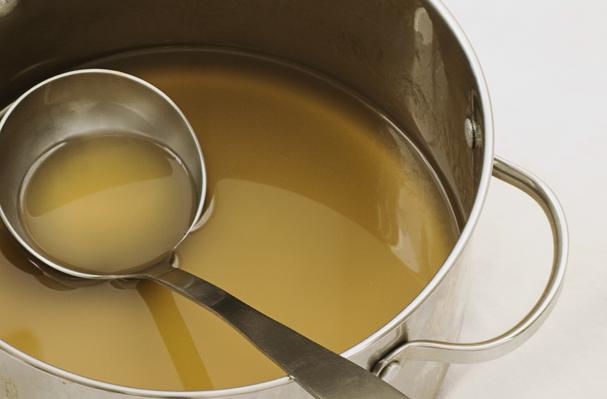White Veal Stock (Fond Blanc De Veau)

Category: Soups & Salads | Blog URL: http://themoderngastronomer.blogspot.com/2010/01/taking-stock-ending-year-beginning-fond_9903.html
This recipe was entered in The Foodista Best of Food Blogs Cookbook contest, a compilation of the world’s best food blogs which was published in Fall 2010.
Ingredients
Preparation
Tools
About
A few weeks ago, on a typical morning, I woke up out of a much longer than usual sleep. I walked into my kitchen to begin the day and looked out the window. It was the kind of morning I imagine feels like a very late afternoon somewhere in Siberia; a cold, brooding blue refusing to acknowledge anything remotely decent or civilized. I felt it everywhere. And suddenly, inexplicably, I felt the need to make stock. A big, rich, aromatic pot of meat stock, bubbling and simmering all day long. And without really thinking about it, I realized that winter had finally, truly arrived here in New York.
It makes sense that I wanted to get that big pot simmering away. The act of making a stock feels appropriately symbolic of the end of the year. After a full (and let's be honest, pretty rough) year, the time has come to pull together all the leftover bits and scraps and find a way to slowly coax new life and sustenance from the bones of the past year. Remnants broken down, made new and stored away, providing a means to sustain us during the cold winter months, and a foundation to build on in the new year. There is an inherent concept of frugality and resourcefulness weaved into the process as well that definitely feels timely and appropriate.
But beyond any symbolic or other significance, a good stock is simply one of the most fundamental elements of cooking. Its hard to overstate it's importance, and I'm not just talking about the haute-cuisine, demi-glace sense of important. Nearly all cultures and cuisines have some version of a stock that's used as a staple (usually as soup or cooking liquid), whether it be a fish stock in Thailand, a pork stock in Japan, a veal stock in France, or a chicken stock here in the United States. It should be no surprise then that the French term for stocks, fonds de cuisine, literally translates to the foundation of the kitchen.
Yet for the most part, real stock is treated as anything but essential in our everyday culture. Most people think of stock as something that comes out of a can or carton you pick up at the grocery store. Something that requires almost no thought, preparation or effort, and bears no relation or connection to what it comes from - a few vegetables and the bones of an animal.
Personally, I never buy supermarket stock. If I don't have a homemade stock on hand, I simply don't make anything that requires it. But I also almost never make a clean, proper, all-day stock either. Generally its more like throwing veggies and the carcass from a roasted chicken, or some random bones and bits together to make a small amount of quick, dirty, (and to be honest) rather unimpressive stock.
But a well-made fond de veau, or veal stock, is anything but unimpressive or ordinary. Any real chef or cook out there knows this. In his book The Elements of Cooking, Michael Ruhlman talks fanatically about the marvels of veal stock, describing it as "one of the most powerful tools in professional kitchens, one of the biggest guns in the professional chef's entire arsenal...if there's a single ingredient that could transform a cook's repertoire at home, it's veal stock." So what exactly makes it so special? Essentially, two primary qualities: it's rich yet relatively neutral flavor (which makes it versatile enough to use with nearly any dish, unlike beef or chicken broths), and the velvety mouthfeel it imparts due to the high gelatin content derived from the collagen in the bones. It gives a dish that certain savory, textural quality you can't quite put your finger on, but most definitely know is in there. Basically, there's nothing else like it.
At this point I feel obligated to at least touch on the ethical concerns over eating veal. I do feel a serious degree of unease and guilt over eating traditionally, inhumanely crated veal. As a meat, I almost never eat it at home or in restaurants; maybe a couple times a year at most. As for using the bones for stock, in some way I feel slightly less guilt. Perhaps because it represents making use of the leftover parts of an animal that has already been killed primarily for meat. Perhaps that's just one of my rationalizations. In any case, I can't morally justify making veal stock regularly; once or twice a year will have to do. And for any future stocks I will certainly be insisting on first finding a reliable source of humanely raised veal to get bones from.
With that said, now lets get into the stock itself. There's a lot of information out there on veal stock, and I would say that Thomas Keller's recipe from The French Laundry Cookbook is perhaps the most comprehensive (and laborious) verison, and Carol Blymire's blog, French Laundry at Home, gives a nice step-by-step breakdown of Keller's recipe for all of us online as well. Michael Ruhlman also has an excellent preparation, and I consulted Julia Child's version from Mastering The Art of French Cooking, which is a great streamlined recipe, and is informative on the basics of stocks and their various incarnations. If you're going to take the time to make this stock, I would suggest checking out at least these few recipes to get a good sense of the differences in preparation, ingredients, etc., realize how they will affect your final product, and adjust your preparation accordingly.
I decided on making a white veal stock, because I wanted a stock without too much color or specific flavor. Something I could use to add body to a soup, make sauces, braise meats and vegetables, or use for a beautiful risotto. So for a white stock, I would not be roasting the bones, or adding any tomatoes or tomato paste at any point, both of which would be used in a brown stock (of which there are, of course, a number of variations on).
Despite all this talk about how special it is, a veal stock is really no more difficult than any other stock to make. Essentially its just meat, bones, aromatics (vegetables & spices) and water, all simmered in a pot together. That's it. But everything you put in will have a specific effect on the final product, so there are a few things to keep in mind for each of these ingredients:
Meat & Bones: It's important that you get bones that are both meaty and have a good amount of exposed bone marrow and connective tissue. Shank, neck, back, rib and knuckle bones are all good, and I would suggest a nice mix of a few types of these bones if it's possible. The marrow and connective tissue contain significant amounts of collagen, which breaks down into gelatin, giving the rich body and texture you want in your stock. When your stock is finshed, there should be enough gelatin present that the stock will solidify like a big old bowl of Jell-O in the refrigerator. The flavor, however, comes primarily from the meat, so if you don't have nice meaty bones you'll probably want to add meat, otherwise you'll end up with a weak, bone-flavored stock. The mixture should ideally be somewhere around half meat, half bone. The best way to find good bones is to just go out and talk to your local butchers. Most will be willing to sell you what they have, and will let you take a good look at the bones and cut them up for you however you like. If they don't have any in stock, you can even inquire about ordering them. Veal bones are sold to restaurants and butcher shops, frozen, in 50 lb. boxes. I found that if you make an offer to buy 10 lbs. or more, some places will actually be willing to order a whole box. All you have to do is ask. For you online types, FreshDirect is actually a great resource, as they regularly carry frozen veal bones (although you can't see exactly what you're getting).
Aromatics: The basic mixture of vegetables is a traditional mirepoix of onion, carrot and celery, along with garlic. However some recipes substitute leeks for celery, claiming that the celery adds too much bitterness. Some recipes use celery, with leeks being optional. I decided to use both, and just cut down on the amount of celery, using only about 1/3 of what is usually called for. The other thing to note when deciding on your mirepoix is color. If you truly want a white stock, with as little color as possible, then you may want to substitute parsnips for the carrots. The carrots will give some of their color off to the liquid, resulting in a pale yellow color to the stock. I used the carrots, because I love their flavor, and wasn't really worried about the bit of color they added. For the bouquet garnis of herbs & spices, you can of course use whatever you like. I think less is more, and stuck to the basics of bay leaf, thyme, parsely, and peppercorns, all tied up in a spice pouch or cheesecloth.
When it was all said and done, the stock turned out great and was exactly what I was looking for. Warming up my apartment on a cold winter day, filling the air with an unbelieveably delicious smell (something like the best pot roast ever), and of course, filling my freezer with rich, delicious stock that I imagine will last me through the depths of winter, well into spring and beyond (if I don't get greedy). However long it lasts, I'm expecting everything at my place will be tasting a whole lot better this year.











Comments
August 5, 2011
Hi From these findings?